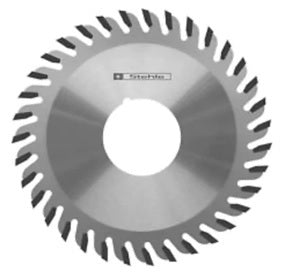Your cart is currently empty.
Quality Control: The Impact of Brandt Edgebander End Snip Blades on Furniture Quality
When it comes to furniture manufacturing, precision is what differentiates between a sturdy, well-finished piece of furniture and a shoddy, unreliable one. Every step in the production process matters, and one often-overlooked tool in this regard is the humble end snip blade.
Curious about what kind of a difference these would make? Here, we'll unravel how Brandt edgebander end snip blades can spell the difference between top-notch furniture, and average, run-of-the-mill quality.
Brandt Edgebander: Precision at its Finest
One of the primary ways end snip blades impact furniture quality is through precision. They operate with meticulous accuracy, cutting the edgebanding material with a level of precision that's nearly impossible to achieve manually.
This precision ensures that every edge is uniform, smooth, and free of imperfections. The result? Furniture pieces that not only look exquisite but also fit together seamlessly.
Imagine a cabinet with edgebanding that's slightly misaligned or unevenly trimmed. It's not only an eyesore but also compromises the functionality of the furniture. Drawers may not close properly, doors may not align, and the overall quality takes a hit. With Brandt end snip blades, such issues become a thing of the past.
Consistency in Craftsmanship
Craftsmanship is at the heart of furniture production. Skilled artisans take pride in their work, aiming for consistency and excellence in every piece they create.
However, even the most skilled craftsmen can benefit from a little assistance. End snip blades provide this assistance by ensuring that the finishing touches on furniture are consistently excellent.
Let's consider the production of a series of identical chairs for a restaurant. Each chair requires precise edgebanding to maintain uniformity. Manually trimming the edgebanding on each chair risks variations in the finished product.
However, by using Brandt end snip blades, the process becomes highly consistent. Each chair comes out with precisely trimmed edges, contributing to the overall uniformity of the furniture set.
A Comparison with Manual Trimming: The Efficiency and Precision of End Snip Blades
When it comes to furniture production, precision and efficiency can’t be ignored. One critical aspect where this holds true is in the trimming of edgebanding.
Traditionally, this process was carried out manually, relying on the skill and dexterity of craftsmen. While skilled hands can achieve remarkable results, the introduction of end snip blades has revolutionized this aspect of furniture manufacturing.
1. Quality Comparison
When comparing the quality of edgeband trimming, end snip blades shine. They operate with a consistent, machine-guided precision that's hard to replicate manually. Each cut is uniform, leaving no room for variations that can occur in the manual trimming process.
2. Efficiency
Efficiency is the heartbeat of modern manufacturing. While manual trimming can be labor-intensive and time-consuming, end snip blades operate swiftly and with minimal human intervention. This translates to faster production cycles, reduced labor costs, and ultimately, more competitive pricing for the finished furniture.
3. Consistency
Consistency is where end snip blades truly stand out. In manual trimming, even the most skilled craftsmen may encounter variations in the quality and precision of cuts. End snip blades, on the other hand, provide unswerving accuracy, ensuring that each piece of furniture receives the same high-quality finish.
Maintenance and Care Tips: Extending the Life of Your End Snip Blades
The longevity and effectiveness of your end snip blades are closely tied to how well you maintain and care for them. Just like any precision tool, they require attention and proper handling to continue delivering top-notch results. Here are some practical maintenance and care tips:

- Cleaning: Regularly clean your end snip blades after use. Residual adhesive and wood particles can accumulate on the blades, affecting their performance. Use a soft brush or a specialized cleaning solution to remove any buildup.
- Lubrication: Keep the moving parts of your end snip blades properly lubricated. This reduces friction, prevents premature wear, and ensures smooth operation. Be sure to use a lubricant recommended by the blade manufacturer.
- Inspect for Damage: Before each use, inspect your end snip blades for any signs of damage, such as chipping or dulling. Damaged blades can compromise the quality of the trim and should be replaced promptly.
- Tighten Fasteners: Check and tighten any fasteners or screws that hold the blades in place. Loose components can lead to vibrations and imprecise cuts.
- Storage: When not in use, store your end snip blades in a dry and clean environment. Consider using blade protectors or covers to prevent accidental damage.
- Professional Sharpening: Over time, end snip blades may require sharpening. Avoid attempting this yourself unless you have the necessary expertise. Instead, seek the services of a professional blade sharpening provider to maintain the blade's edge.
By following these maintenance and care tips, you'll not only extend the life of your end snip blades but also ensure that they consistently deliver the precision and efficiency that your furniture production demands.
Elevating Furniture Quality with Brandt End Snip Blades
Whether you're a furniture manufacturer looking to optimize your production process or a woodworking artisan looking to improve the overall quality of their craft, Brandt edgebander tools can help you gain a whole other level of precision and consistency.
Thankfully, here at CarbideTooling.net we offer a range of premium tools and equipment, including Brandt end snip blades, that can help you turn those quality aspirations into reality.
Equip yourself with the proper tools to transform your woodworking projects into excellent masterpieces.


